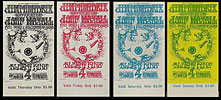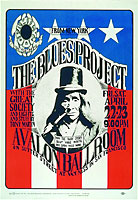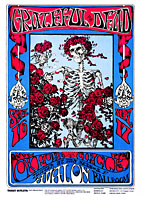Consisting of almost 300 posters, the Bill Graham numbered series remains one of the seminal series in rock poster history. With images and designs that blew apart long standing graphic design and advertising conventions, posters in this series document performances by now legendary musicians such as Jimi Hendrix, Janis Joplin, Led Zeppelin, Otis Redding and many others. Groundbreaking poster artists such as Rick Griffin, Wes Wilson and Lee Conklin contributed important work to this series that remains vibrant and inspiring to this day.
The Bill Graham numbered series is extremely well documented - a circumstance which is quite advantageous to collectors some forty years after most of these posters were printed. The series is widely collected and rare items in the series are among the most sought after pieces in the world of rock posters. The two key reference works for this series are "The Art of the Fillmore" and "The Art of Rock".
A great deal is known about the printing history of the posters in this series (although debate continues with respect to a number of the posters and new discoveries are still being made from time to time). Many of the posters were printed multiple times during the era. Counterfeits also exist for several of the images so collectors are well advised to seek out the advice of a reputable authority when in doubt about the authenticity of a poster.

The Bill Graham numbered series is not limited solely to posters. Handbills and postcards containing the poster image were also produced. In addition, beginning in the summer of 1967, tickets to these shows contained miniature poster images in varying color combinations for different days of the same run of shows.

Traditionally, poster collectors have considered the Family Dog numbered series to be at least as important as the Bill Graham series. Chet Helms, whose name has become synonymous with the Family Dog, was central a figure in the Haight Ashbury hippie community and had his finger securely on the pulse of the times. It was through his foresight and diligence in spreading the word of the new ethic by distributing posters throughout the community that the psychedelic poster movement took form. It is this close association with the most positive elements of the times that has endeared the Family Dog posters to a whole generation of collectors.
However, due to a convoluted set of circumstances, the Family Dog series is not nearly as well documented as the Bill Graham series. For example, The Art of Rock contains only a limited number of posters in the Family Dog series and there is no comparable work to The Art of the Fillmore that addresses the Family Dog series. As a result, many newer collectors have tended to ignore or overlook the Family Dog series.
It is also more difficult to define the precise boundaries of the Family Dog numbered series. There are 147 numbered posters commemorating Family Dog produced shows at the Avalon Ballroom in San Francisco from 1966-1968. But there are also numbered posters for shows produced by the Family Dog in Denver, Colorado and Portland, Oregon. In addition, there are unnumbered posters and handbills associated with shows produced by the Family Dog in San Francisco in 1969 and 1970.

The Family Dog numbered series contains some of the signature poster images from the 1960's such as Mouse \& Kelley's "Zig-Zag" man (FD # 14) or their "Skull \& Roses" Grateful Dead poster (FD # 26). The series also contains a number of important works by Rick Griffin such as the number D18 poster commemorating the 1967 new years show by the Doors in Denver.
As is true for the Bill Graham series, images in the Family Dog series were released both as posters and as handbills or, later in the series, as postcards. Six months before Bill Graham followed suit, the Family Dog began using image tickets generally with a monocolor poster image.
The printing history of the Family Dog numbered series is also well known. Many of the posters were printed several times and counterfeits exist of several of the posters as well as a number of the handbills. As is true for the Bill Graham numbered series, those collecting Family Dog items will be well advised to seek out the advice of a reputable authority when in doubt about the authenticity of a poster.
On March 3 1988, Bill Graham Presents once again began presenting concerts at the original Fillmore Auditorium on an ongoing basis. BGP initiated the Fillmore numbered series on March 4, 1988 commemorating a concert by Hot Tuna (and "friends" Paul Kantner, Grace Slick and Papa John Creech).
The Fillmore Auditorium was severely damaged by a major earthquake in October 1989. But following a major retrofit of the building, BGP "reopened" the Fillmore in late April 1994 and has continued to issue posters in the Fillmore series.
Today, the Fillmore numbered series includes over 1,600 posters commemorating shows by an incredible range of artists from superstars like Tom Petty to local favorites such as Vinyl. The series has provided an opportunity for established poster artists such as Randy Tuten and newer artists such as Chris Shaw to add to the long tradition of exciting poster art associated with the Fillmore.
In the generous tradition established by Bill Graham in 1966, these posters have been and are still handed out to patrons at the end of the show! However, posters are not produced for all shows and the poster art is not generally used on handbills produced by BGP to advertise shows at the Fillmore.
Bill Graham Presents has a second long-running posters series - the Bill Graham Presents Numbered Series. This series had its start in 1985 when BGP # 1 was released to commemorate a concert at the Fillmore Auditorium by Rueben Blades. The series of 362 numbered posters ran through May 18, 2008 when BGP held it's final show at the Warfield headlined by Phil Lesh and Friends. Generally, BGP posters commemorated concerts by major acts at large venues (e.g. The Rolling Stones or the Grateful Dead at the Oakland Coliseum). As a result, BGP posters generally were not handed out to patrons at the shows. Needless to say, posters in this series are generally tougher to find than posters in the Fillmore numbered series.
© 1999-2008 Dennis King / RockPosterCollector.com © All Rights Reserved
© Dennis King / D. King Gallery All Rights Reserved